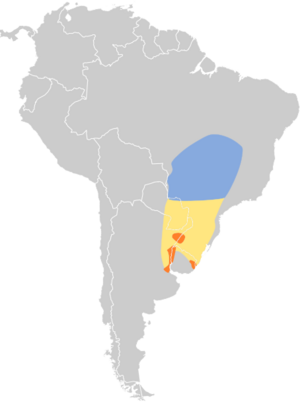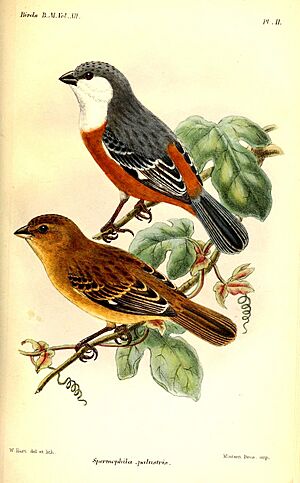Marsh seedeater facts for kids
Quick facts for kids Marsh seedeater |
|
|---|---|
 |
|
| Male | |
| Conservation status | |
| Scientific classification | |
| Genus: |
Sporophila
|
| Species: |
palustris
|
 |
|
| Non-Breeding Breeding Passage | |
The marsh seedeater (Sporophila palustris) is a small bird that belongs to the Thraupidae family. These birds are known for their different looks between males and females. The male marsh seedeater has a bright white throat, a grey head, and a reddish-brown belly. Female marsh seedeaters look more like other brown female seedeaters.
These birds live in parts of Argentina, Brazil, Paraguay, and Uruguay. They are migratory, which means they travel long distances. They spend their breeding season in wet grasslands and marshes in Uruguay and Argentina. When winter arrives in the southern hemisphere, they fly north to wet and dry grasslands in southern Brazil.
Contents
About the Marsh Seedeater
The marsh seedeater is a special bird found in South America. It was first described in 1883 by Walter B. Barrows. These birds are quite small, but the males have very noticeable colors.
Where Marsh Seedeaters Live
Marsh seedeaters prefer specific places to live. They like wet grasslands and marshy areas. These habitats provide them with the food and shelter they need. During the non-breeding season, they can also be found in drier grasslands.
Why Marsh Seedeaters Travel
Like many birds, marsh seedeaters migrate to find the best conditions. They move from their breeding grounds in the south to warmer areas in the north for the winter. This journey helps them find enough food and avoid harsh weather.
Protecting the Marsh Seedeater
The marsh seedeater faces several challenges that threaten its survival. People are working to protect this species and its home.
Threats to the Marsh Seedeater
One major problem for the marsh seedeater is habitat loss. This means the places where they live are disappearing. Their homes are being turned into farms or cities. Another threat is illegal trapping. Some people catch these birds to sell them as pets. Pesticides, which are chemicals used to kill insects, also harm these birds.
How We Can Help
Many efforts are being made to protect the marsh seedeater. It is now protected in most of the areas where it lives. Several special protected areas have been set up. These areas help keep their habitats safe. Protecting these places is important for the future of the marsh seedeater.
The Entre Ríos Seedeater: A Close Relative
There is another rare seedeater that looks very similar to the marsh seedeater. It is sometimes called the Entre Ríos seedeater (Sporophila zelichi). This bird breeds in the Entre Ríos province of Argentina. A few have also been seen in other parts of Argentina, Paraguay, and Uruguay.
Differences and Similarities
The Entre Ríos seedeater has a wide white collar around its neck. Its back is reddish-brown, not grey like the marsh seedeater. The reddish color on its belly is also darker. However, the songs of the few Entre Ríos seedeaters recorded sound just like the marsh seedeater's song.
Is it a Separate Species?
Scientists have debated whether the Entre Ríos seedeater is a separate species. Some think it might just be a different color variation of the marsh seedeater. Others believe it could be a mix between the marsh seedeater and another bird called the chestnut seedeater. For now, many experts consider it to be part of the marsh seedeater species. If it were a separate species, it would be in great danger of disappearing.



